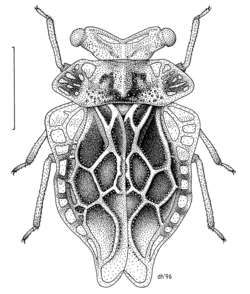Biology:Coleorrhyncha
| Coleorrhyncha | |
|---|---|

| |
| Oiophysa distincta (Peloridiidae) | |

| |
| Specimen of Xenophyes forsteri | |
| Scientific classification | |
| Domain: | Eukaryota |
| Kingdom: | Animalia |
| Phylum: | Arthropoda |
| Class: | Insecta |
| Order: | Hemiptera |
| Suborder: | Coleorrhyncha Myers & China, 1929 |
| Families | |
| |
Coleorrhyncha or Peloridiomorpha, also known as moss bugs or beetle bugs, are a suborder of Hemiptera and represent an ancient lineage of moss-feeding insects. They show some similarities to the Heteroptera but have been considered distinct. It has a single extant family, the Peloridiidae. They are 2 to 5 millimetres (0.079 to 0.197 in) in length, and feed on moss and liverworts.[1] They have wings in some species which are reduced in others but all species are flightless and live in damp moss habitats and are associated with the distribution of Nothofagus trees in Australia, New Zealand, New Caledonia, and South America, which all were formerly part of the supercontinent Gondwana.[2]
Three other major families have been established on the basis of fossils: Progonocimicidae (Late Permian to Late Cretaceous) Karabasiidae (Jurassic-Early Cretaceous) and Hoploridiidae (Early Cretaceous), which have been found in both the Northern and Southern Hemispheres.[3] The oldest member of Coleorrhyncha is Permoridium from the early Permian (Asselian to early Sakmarian ~290-300 million years ago) of Germany, which appears to be more closely related to Peloridiidae than to any of the extinct families.[4] The Coleorrhyncha were earlier included within the "Homoptera" but based on studies of their morphological similarities as well as molecular phylogeny are now considered as a sister group of the Heteroptera.[5]
The fossil family Progonocimicidae was formerly considered as early Heteroptera or survivors from a stem group of Heteropteroides[6] but based on morphology, Popov called them an ancestral sub-group of the Coleorrhyncha,[7] and this has been followed by subsequent authors.[8][5][9][2]
References
- ↑ Ye, Zhen; Damgaard, Jakob; Burckhardt, Daniel; Gibbs, George; Yuan, Juanjuan; Yang, Huanhuan; Bu, Wenjun (April 2019). "Phylogeny and historical biogeography of Gondwanan moss-bugs (Insecta: Hemiptera: Coleorrhyncha: Peloridiidae)" (in en). Cladistics 35 (2): 135–149. doi:10.1111/cla.12237. PMID 34622982.
- ↑ 2.0 2.1 Szwedo, Jacek; Azar, Dany; Ziadé, Kamil (2011). "The first Progonocimicidae (Insecta: Hemiptera: Coleorrhyncha) from Lower Cretaceous Lebanese amber". Insect Systematics & Evolution 42 (2): 161–177. doi:10.1163/187631211x578415. https://www.researchgate.net/publication/221760949.
- ↑ Jiang, Tian; Wang, Bo; Szwedo, Jacek (2019-01-01). "The first representative of Progonocimicidae (Hemiptera: Coleorrhyncha) from mid-Cretaceous Burmese amber" (in en). Cretaceous Research 93: 346–359. doi:10.1016/j.cretres.2018.09.018. ISSN 0195-6671. https://www.sciencedirect.com/science/article/pii/S0195667118301812.
- ↑ Burckhardt, Daniel; Nel, André; Raisch, Manfred; Poschmann, Markus J. (2022-04-21). "A new putative moss bug (Insecta: Hemiptera) from the lower Permian of the Saar-Nahe Basin, SW Germany, and the age of Coleorrhyncha" (in en). Historical Biology 35 (6): 832–837. doi:10.1080/08912963.2022.2067759. ISSN 0891-2963. https://www.tandfonline.com/doi/full/10.1080/08912963.2022.2067759.
- ↑ 5.0 5.1 Brożek, Jolanta (2007), Labial sensillae and the internal structure of the mouthparts of Xenophyes cascus (Bergroth 1924)(Peloridiidae: Coleorrhyncha: Hemiptera) and their significance in evolutionary studies on the Hemiptera, http://jaf.student.kul.lublin.pl/files/323/03brozek.pdf
- ↑ Hennig, Willi (1981). Insect Phylogeny. New York: Wiley. ISBN 978-0-471-27848-1. https://archive.org/details/insectphylogeny0000henn. Translated by A. C. Pont. Originally published in 1969 as Die Stammesgeschichte der Insekten Frankfurt, Waldemar Kramer
- ↑ Popov, Yu A. (1981). "Historical development and some questions on the general classification of the Hemiptera". Rostria 33 (Supplement): 85–99. Popov, Yu A.; Shcherbakov, Dmitry E. (1991). "Mesozoic Peloridioidea and their ancestors (Insecta: Hemiptera, Coleorrhyncha)". Geologica et Palaeontologica 25: 215–235.
- ↑ Wheeler, Ward C.; Schuh, Randall T.; Bang, Ranhy (1993). "Cladistic relationships among higher groups of Heteroptera: congruence between morphological and molecular data sets". Insect Systematics & Evolution 24 (2): 121–137. doi:10.1163/187631293X00235.
- ↑ Heads, Sam W. (2008). "A new species of Yuripopovia (Coleorrhyncha: Progonocimicidae) from the Early Cretaceous of the Isle of Wight". British Journal of Entomology and Natural History 21: 247–253. Archived from the original on 2013-12-19. https://web.archive.org/web/20131219031104/http://fossilinsects.net/pdfs/Heads_2008_BJENH_YuripopoviaEarlyCretIsleOfWight.pdf.
Other reading
- Hoch, H. (2006). "Vibrational signalling in a Gondwanan relict insect (Hemiptera: Coleorrhyncha: Peloridiidae).". Biology Letters 2 (2): 222–224. doi:10.1098/rsbl.2006.0451. PMID 17148367.
- Myers, John Golding; China, William Edward (1929). "The systematic position of the Peloridiidae as elucidated by a further study of the external anatomy of Hemiodoecus leadi China". Annals and Magazine of Natural History 105 (3): 282–294. doi:10.1080/00222932908672971.
- Popov, Yu A.; Shcherbakov, Dmitry E. (1996). "Origin and evolution of the Coleorrhyncha as shown by the fossil record". in Schaefer, Carl W.. Studies on Hemipteran Phylogeny. Lanham, Maryland: Entomological Society of America. pp. 9–30. ISBN 978-0-938522-54-6.
- Shcherbakov, Dmitry E. (2005). "Fossils versus molecules and cladistics: controversies over the Hemiptera phylogeny". 12th International Auchenorrhyncha Congress, Berkeley, Volume 7.
- Wang, Bo; Szwedo, Jacek; Zhang, HaiChun (2009). "Jurassic Progonocimicidae (Hemiptera) from China and phylogenetic evolution of Coleorrhyncha". Science in China Series D: Earth Sciences 52 (12): 1953–1961. doi:10.1007/s11430-009-0160-6. Archived from the original on 19 December 2013. https://web.archive.org/web/20131219033514/http://159.226.74.248:8000/pagelinks/150276.pdf.
Wikidata ☰ Q15728076 entry
 |

